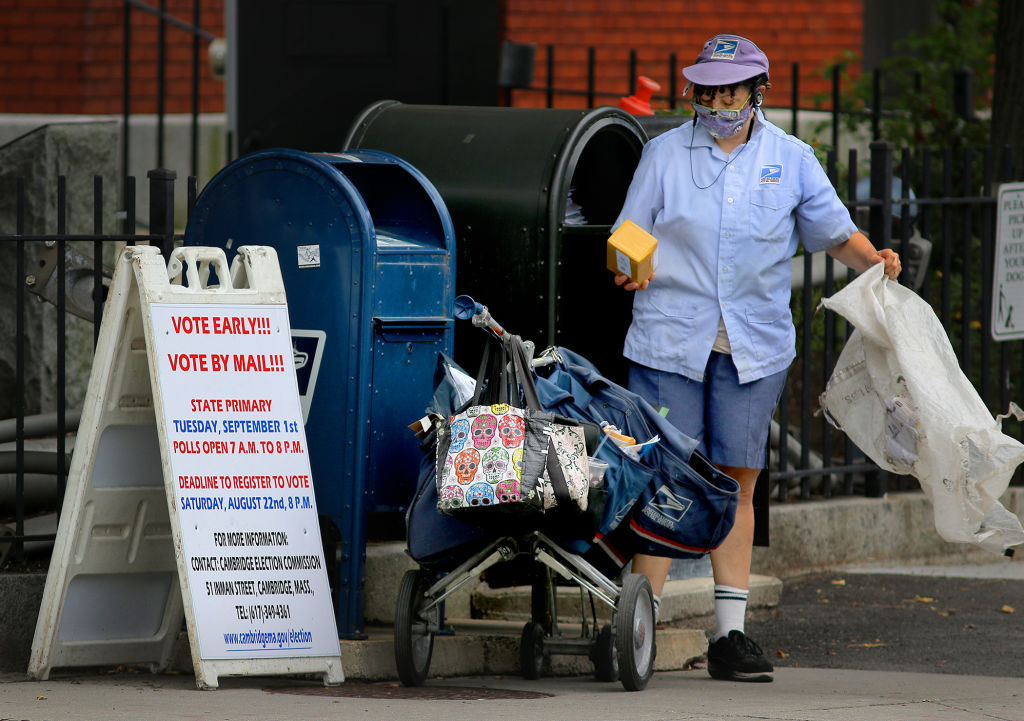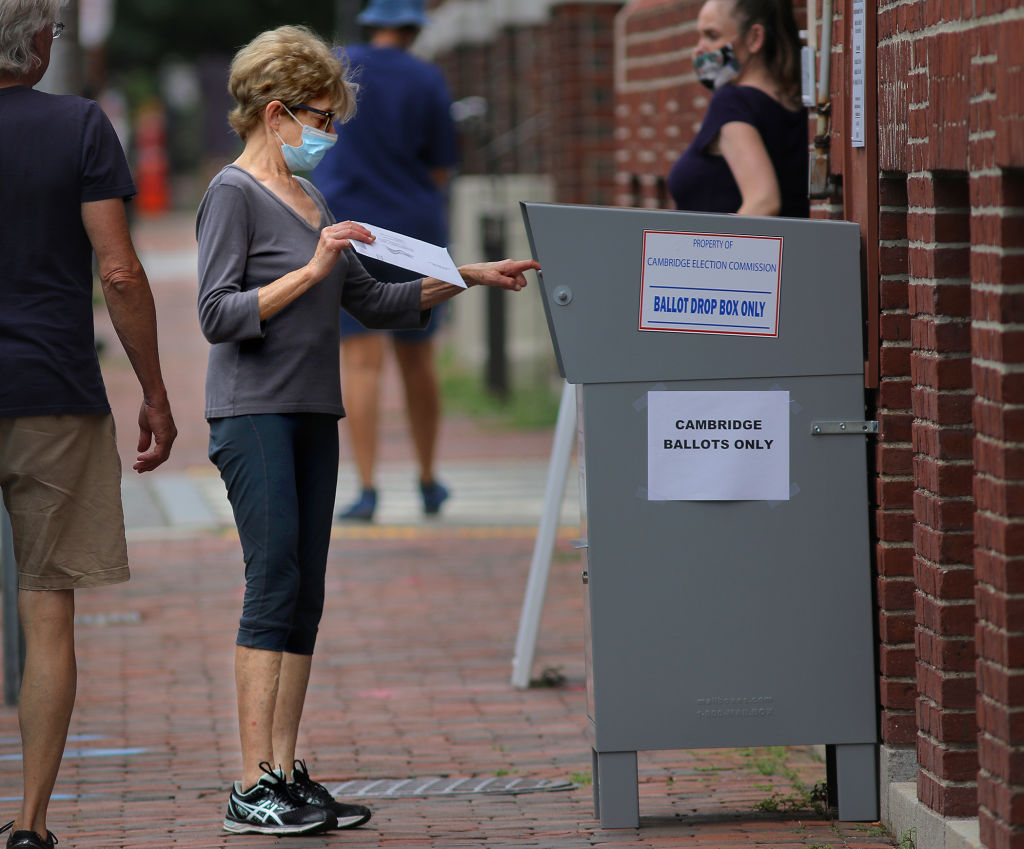
Postmaster General Louis DeJoy has spent the last month in damage control-mode.
Once it became clear in August that his ambitious cost-cutting agenda had slowed mail delivery, spurred a national backlash, and fueled allegations that he was using his perch to aid President Donald Trump’s reelection, he announced he was suspending some of these initiatives “to avoid even the appearance of any impact on election mail.” Since then, he has expanded the United States Postal Service’s election task force, launched a website dedicated to mail-in voting, and vowed that his organization “is fully ready, willing and committed to deliver the nation’s Election Mail timely and securely.”
But the jury is still out on whether all these efforts will amount to much. In conversations with more than a dozen postal workers and local postal union representatives, all expressed doubt that the ballot delivery process will go smoothly in October and November. Two union representatives in Michigan and Pennsylvania told TIME that mail is still piling up at processing plants, in part because the workforce is short-staffed due to the coronavirus, but also because some of DeJoy’s cost-cutting measures are still in effect.
“I totally believe in the security [of mail-in-voting]. I have no problem mailing things, whether its bills or goods,” says Maria Risener, a window clerk in Lynden, Washington. But is she concerned that ballots will be delivered in a timely fashion? “Yeah definitely. [DeJoy’s] not putting things back the way they used to be, he’s just putting things on pause.”
None of the workers or representatives interviewed by TIME said they had seen a concrete plan for how USPS plans to address a surge of mailed ballots. None reported receiving concrete guidelines from their superiors. “We’re not being told anything – they’re not discussing the election with us,” says Roscoe Woods, President of the 480-481 Local American Postal Workers Union in Michigan. “The only thing they’re doing is giving service talks reminding people not to talk to the media.” Several of the people interviewed expressed distrust specifically in DeJoy.
When asked about these complaints, a Postal Service spokeswoman pointed to a video the organization released on Thursday featuring DeJoy and the four representatives of the largest postal unions vowing to work together, and to a press release showing USPS service scores were improving. But a USPS statement provided to TIME included a lengthy entreaty to voters to take into account the complex and time-consuming process of transporting, processing, and delivering ballots.
“The United States Postal Service is fully committed to fulfilling our role in the electoral process when public policy makers choose to utilize us as a part of their election system, and to delivering Election Mail in a timely manner consistent with our operational standards,” the spokeswoman, Martha Johnson, said in a statement. “We do ask election officials and voters to be mindful of the time that it takes for us to transport, process and deliver ballots from the election mail officials to the voters, the time that it takes for voters to consider and prepare their ballots, and the time that it takes for a ballot to be transported, processed, and delivered back to the election official after it is placed by the voter back into the mail stream, based upon our usual delivery standards which have not changed.”
In a subsequent statement, Johnson emphasized that DeJoy’s cost-cutting measures have been effective: “As a result of these initiatives, our on-time departures are approaching 98 percent and extra trips are down by over 70 percent.” But those metrics may not be meaningful to most Americans, who are primarily concerned that their mail—including time sensitive parcels, like ballots and prescription drugs—are delivered in a timely manner.

The process for voting by mail is relatively straightforward. State and local officials send ballots to voters eligible for mail-in voting. (Eligibility varies by state. In states where there is universal mail-in voting, all eligible voters automatically receive a ballot. In other states voters must proactively request one). Voters then fill out the ballots and mail them back via First Class mail, which means it goes to the top of the priority list for sorting and delivery.
Postal service officials say that, in past election cycles, they usually received a reminder to prioritize ballots, and were accustomed to doing so. While this system often meant that close races often could not be determined on election night, the process itself rarely became a national story. “It was a non-issue,” says Risener, whose home state of Washington has voted solely by mail for nearly a decade..
But this year, two disparate problems have converged. The first was the unexpected global pandemic, which put mail carriers on the front lines, depleting the workforce as people took absences after contracting the virus or becoming exposed to it. By April, 900 workers had tested positive; as of September, that number had increased to over 10,000. More than 80 have died, according to a union representative. The smaller workforce meant that those who remained were frequently putting in overtime—sometimes without protective equipment—to compensate for their colleagues’ absences.
The second problem was that all this was happening during the primary election season, with more states increasing eligibility for vote-by-mail. An internal audit by the postal service of primary elections in May and June found that the ballot delivery process didn’t always run smoothly. Some of the most egregious errors flagged by the report—including that a million ballots in multiple states were sent out late—were clearly the fault of election boards. But the report also found that the percentage of election mail delivered on time between April and June of 2020 had decreased by 1.7%, to 94.5 percent, compared to the same window in 2018.
This internal audit was conducted before DeJoy’s cost-cutting measures had gone into effect, and postal workers warn that USPS’s capacity to delivery mail in a timely fashion could potentially worse now than it was earlier this year. In testimony before Congress, DeJoy said he was not responsible for some of these measures, including the removal of sorting machines and overtime elimination. But he did claim responsibility for a directive requiring employees who pick up mail at processing plants to leave on schedule—even if their trucks were not yet full. Experts and postal advocates say that directive contributed to the slowdown in mail delivery and may impede the delivery of election mail.
While DeJoy, under pressure in August, suspended his reform initiatives until the election, some union officials and workers tell TIME that they’re still in effect. Woods, the local postal union President in Michigan, says that mail carriers are still leaving the processing plant in Pontiac on schedule, even when their trucks are 20% full. Kim Miller, the President of the Keystone Area local union in Harrisburg, Pennsylvania, said workers were raising questions about a similar situation. “They’re asking why we have trucks going out without any mail on it, and why the mail flow is changing every day,” she said.
When asked about these complaints, Johnson, the USPS spokesperson, said DeJoy’s directive to have trucks leave on time was still in effect.
Other union representatives have pointed at the recent removal of mail sorting machines—a routine measure that predates DeJoy, but raised eyebrows this year when they were removed at a higher rate than in previous years. (CNN obtained court documents showing USPS removed 711 machines this year, double the amount for a standard year). Michael Moriconi, President of the APWU Tucson Area Local Union, says five sorting machines had been removed from his processing plant since DeJoy took over. Four still aren’t being used, he added, even though workers in the plants are putting in 12 hour days and the mechanized sorters would undoubtedly help. “Its almost as though [management] is trying to make sure we don’t use them to show they are not necessarily needed,” he says.
All of the plants where workers are raising issues are in swing states, which will be crucial in determining the outcome of the presidential race. All of the officials TIME spoke with said they were concerned about handling an expected influx of ballots given the current restrictions. “I have all the confidence in the world we will be able to handle the mail volume… if more people than ever do mail in ballots this year,” says Mariconi. But, he notes, “the fact that the [sorting] machines have been taken out and the processing abilities have been hampered so much, it’s going be a lot more difficult than it could have been.”
This uncertainty is compounded by a lack of communication from top management. Postal workers across the country told TIME that they hadn’t heard about the inaugural meeting of the expanded election task force, which DeJoy touted as a success earlier this month. One of the workers in an Arizona plant, who requested anonymity for fear of retribution, said that since DeJoy has come under criticism, communication with local management has declined. When he first assumed the post in May, employees received what’s known as “stand-up talks”—or casual updates from local management—almost daily. Usually, the stand-up talks focused on new proposals or coronavirus issues. “Since the whole thing started, and the media got a hold of this and Congress started investigating the Postmaster General, those stand-ups have dribbled down to maybe once a week, once every two weeks,” says the worker. “And its pretty much on every-day type things, not the election.”
Union executives at the national level, who pushed to be included in the election task force and attended the inaugural meeting last Thursday say that Postal Service executives have relayed a plan to them that includes a commitment to prioritizing ballots and working with the states to make sure election mail is identifiable. (When TIME asked a USPS spokesperson for details about these plans, the spokesperson pointed to DeJoy’s press release.)
Mark Dimondstein, the President of the American Postal Workers Union, said his organization is pushing USPS management to increase and improve communication with local officials. “One of the things we’re pushing is the stand-up talks have to be done, the training has to be done, it has to be repetitive [and] it has to be reiterated,” he said. “Those are all commitments that are being made in words. Now we have to make sure postal management does it in action.”
More Must-Reads from TIME
- Donald Trump Is TIME's 2024 Person of the Year
- Why We Chose Trump as Person of the Year
- Is Intermittent Fasting Good or Bad for You?
- The 100 Must-Read Books of 2024
- The 20 Best Christmas TV Episodes
- Column: If Optimism Feels Ridiculous Now, Try Hope
- The Future of Climate Action Is Trade Policy
- Merle Bombardieri Is Helping People Make the Baby Decision
Write to Alana Abramson at Alana.Abramson@time.com
